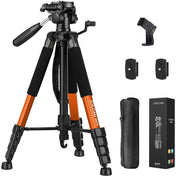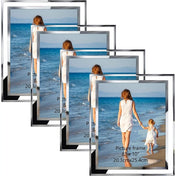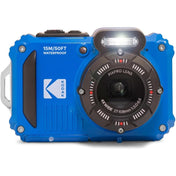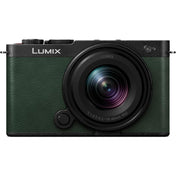Overview
Understanding camera lenses is crucial for improving your photography. Key factors include light control, depth of field, and focal length. Different types of lenses—prime, zoom, and specialty—serve various needs. Choose a lens based on your photography style, budget, and compatibility with your camera. Experimenting with lenses can enhance your skills, and a balanced kit can optimize your shooting experience.
When it comes to photography, one of the most critical elements in your kit is the camera lens. While many photographers tend to focus on their cameras’ bodies, the lens often plays a more significant role in the quality of the images captured. This article explores how different camera lenses can affect your photography, helping you make informed decisions to elevate your skills. Whether you're considering the best lens for Canon EOS or just delving into the world of lenses, we've got you covered.
The Basics of Camera Lenses
Before diving deeper, it’s essential to understand the fundamental components of a camera lens. Each lens helps control light, depth of field, and perspective. Let's break down these concepts:
Light Control
The camera lens is responsible for directing light onto the sensor. The amount of light a lens can gather is defined by its aperture, which is indicated by f-numbers. A lower f-number allows more light, making the lens suitable for low-light conditions. For example, if you are shooting in darker environments and seeking to achieve beautiful bokeh, the best lens for Canon EOS would likely be one with a wider aperture.
Depth of Field
Depth of field refers to the range of distance within a photo that appears sharp. A lens with a wide aperture achieves a shallow depth of field, allowing for beautiful background blur, which is favored in portrait photography. Conversely, lenses with a smaller aperture offer a deeper depth of field, ideal for landscape photography where more of the image needs to be in focus.
Perspective and Focal Length
The focal length of a lens impacts both framing and perspective. Focal lengths are generally categorized into three types:
- Wide-angle lenses (focal lengths less than 35mm): These are great for landscapes and real estate as they capture a wider view.
- Standard lenses (focal lengths between 35mm and 70mm): These lenses mimic the human eye and work well for street and portrait photography.
- Telephoto lenses (focal lengths greater than 70mm): Perfect for wildlife and sports photography, these lenses let you capture subjects that are far away without losing detail.
The Various Types of Camera Lenses
Understanding the types of camera lenses available is crucial for photographers looking to elevate their craft. Here’s a look into some common lens types and when they should be used:
Prime Lenses
Prime lenses have a fixed focal length. While this might seem limiting, they often deliver better optical quality because they are designed to excel at a specific distance. Many photographers prefer prime lenses for portrait photography due to their ability to achieve sharp images and beautiful bokeh.
Zoom Lenses
Zoom lenses offer versatility with a range of focal lengths. They are beneficial for events and travel photography, allowing the photographer to adapt quickly to changing scenes without the need to switch lenses. While some may argue that prime lenses are superior in image quality, the convenience of a zoom lens cannot be overstated.
Specialty Lenses
Specialty lenses, such as macro lenses for close-up photography or fisheye lenses for a creative wide-angle perspective, open new opportunities for unique shots. Each type has its own strengths, and knowing when to use them can enhance your creative capabilities.
How to Choose the Right Lens for Your Needs
Selecting the best lens for Canon EOS or any camera system greatly depends on your specific photographic needs and style. Below are several factors to consider:
Your Photography Style
Consider your primary photography style. Are you more inclined towards landscapes, portraits, or macro shots? Each style may require different lens attributes, so identifying your niche can simplify your lens selection process.
Budget Constraints
Quality lenses can be a significant investment. Determine your budget and explore options within that price range. Remember, investing in a great lens can profoundly impact your photography quality.
Compatibility
Not all lenses are compatible with every camera body. Always check your camera specifications before making a purchase. For those shooting with a Canon EOS, several excellent lens options are available that align with different styles and preferences.
The Impact of Lens Quality on Images
The quality of your lens can dramatically influence the overall aesthetic of your photographs. Here’s how lens quality affects your pictures:
Sharpness
Better quality lenses produce sharper images with more detail. Lens manufacturers often provide information on the resolving power of their products, which is essential for capturing intricate details, especially when shooting macro or landscape photography.
Chromatic Aberration
Lower-quality lenses may exhibit chromatic aberration, resulting in colored fringes around contrasted edges in your images. Investing in higher-quality optics typically reduces this issue, contributing to cleaner, crisper images.
Lens Flare
Lens flare occurs when bright light sources create unwanted streaks in your images. Higher-end lenses often come with special coatings to reduce lens flare significantly, preserving image quality even in challenging lighting conditions.
Experimenting with Lenses
The best way to understand how camera lenses affect your photography is to experiment. Here are some tips for getting started:
Rental Options
If you’re uncertain about investing in a particular lens, consider renting it first. Many camera shops and online services offer lens rentals, allowing you to test before making a purchase.
Workshops and Tutorials
Participate in photography workshops or online tutorials focusing on different lenses. Learning from experts can provide valuable insights and inspire you to experiment with new styles.
Join Photography Groups
Engaging with like-minded photographers can enhance your understanding of lens effects. Join online forums or local photography clubs where you can share experiences and get feedback on your work.
Creating a Balanced Kit
Building a balanced photography kit is essential. Consider having a variety of lens types that cater to different shooting scenarios:
- A versatile zoom lens for general use.
- A prime lens for portraits with a wide aperture.
- A wide-angle lens for landscapes or interiors.
- A macro lens for extreme close-ups.
The Role of Filters
While discussing lenses, it’s important not to overlook filters. Certain filters can enhance the quality of your images, addressing concerns like glare or light balance. Using a polarizing filter can significantly improve the vibrancy of sky and water in landscape photography, for instance.
Understanding Lens Distortion
Lens distortion can affect your images, particularly with wide-angle and telephoto lenses. Understanding the types of distortion:
Barrel Distortion
This distortion causes images to appear spherical, leading to bulging at the center. It’s common with wide-angle lenses but can be corrected in post-processing.
Pincushion Distortion
This type occurs mainly in telephoto lenses, causing the edges of images to appear pinched. Being aware of this can help photographers correct issues in their compositions ahead of time.
Final Thoughts: Unlocking Your Creative Potential
Choosing the right camera lens can transform your photographic journey. Understanding how camera lenses affect your photography allows you to make informed decisions, whether you’re looking for the best lens for Canon EOS or experimenting with other camera systems. The key lies in understanding your needs, exploring your options, and continually pushing the boundaries of your creativity. So, dive deep into your lens collection, experiment, and watch as your photography flourishes!
Linked Product

Canon EF-S 55-250mm F4-5.6 IS II Telephoto Zoom Lens
The Canon EF-S 55-250mm F4-5.6 IS II Telephoto Zoom Lens is ideal for photographers looking to capture distant subjects with clarity and detail. Its Optical Image Stabilizer technology allows for sharper images at slower shutter speeds, making it suitable for low-light conditions. Additionally, the lens effectively reduces chromatic aberration, ensuring high image quality across its zoom range.
View Product









